Header logo
header top contact widget
Tooth Replacement
Misconceptions Of Oral Health
Posted on Sep 14, 2021 by William J. Claiborne, DDS MS
As a periodontal dental specialist, I have advanced skills in the treatment of gum disease and dental implants. In my specialty, I see patients who have various issues related to oral health. Some of these can be resolved with minor treatment and others require more involved procedures.
In many cases, however, a factor in the severity of certain issues occur because it was assumed the problem would resolve itself. Some patients have also assumed that certain signs or symptoms were “normal”.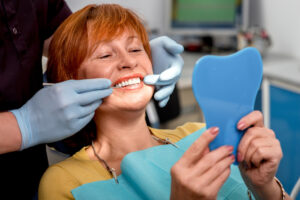
The health of the mouth is largely reliant on the condition of the gum tissues. This moist, soft covering of tissues is a protective blanket for the structures underneath. Gum tissues protect the structures that support natural teeth as well as their roots.
Yet, because the gums are not visible as are teeth, it is easy to “back burner” problems. Some of these problems DO resolve on their own. However, in too many cases, what is set aside eventually requires extensive treatment; treatment that may have easily been avoided with early care.
I’d like to address some of the more common issues I see that are misconceptions…
Assuming seeing blood in the sink when brushing teeth is normal: Srubbing teeth so rigorously that they bleed is not a sign of doing a good job. This action not only wears away precious tooth enamel, it wears away the gum tissues that wrap the base of teeth.
Gums that bleed when brushing are also a symptom of periodontal (gum) disease. In addition, gum disease can cause tenderness, swelling or frequent bad breath. Without treatment, gum disease will progress further. This is why it is the nation’s leading cause of adult tooth loss.
Protect tooth enamel and gum tissues by using a soft to medium bristled toothbrush and a non-abrasive toothpaste (never substances such as baking soda). Using a swirling motion (rather than going back-&-forth), avoid applying too much pressure. Make sure that the tips of the bristles are contacting the surfaces of teeth. Hint: If you notice your toothbrush’s bristles flay outward after a month or so of use, you’re pressing too hard.
Ignoring gum recession: The gums are designed to snugly wrap the base of each tooth, serving to seal out bacteria. Although the aging process and oral dryness can shrink gum tissues, a common cause of receded gums is gum disease.
Gum recession is what causes sensitivity to hot, cold or the bristles of a toothbrush. Oftentimes, a bite of ice cream can send a jolt of pain. Even without the sensitivity, recession can leave the darker tooth root areas exposed. This leaves the tooth vulnerable to damage by oral bacteria.
Ignoring frequent bad breath: Bad breath is typically a by-product of bacteria build up. Although certain medical conditions can contribute to bad breath, keeping oral bacteria levels under control will minimize the risk of having smelly breath odor.
Saliva is what controls a significant amount of oral bacteria. However, without regular brushing and flossing, bacteria can quickly exceed what saliva is able to manage.
This is why it is important to brush twice daily and floss daily. These small tasks help to control bacteria by removing the sticky buildup of plaque. If not removed, plaque hardens into what is known as tartar. Tartar is a destructive mass of bacteria that can no longer be brushed or flossed away.
Having gum depth measurements of four and over: During regular check-ups, hygienists check gum health by gently using a probe along the base of each tooth. This is done to indicate loosening of gum tissues on the front and back sides of teeth. A good check-up will have no depth measurement higher than a three.
If the depth measures a 4 or 5 (or higher), the gums are not sealing out oral bacteria sufficiently. This may be an indication of gum disease. The higher the number, the more advanced it is.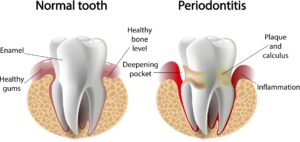
Assuming tooth loss is normal: Some people assume tooth loss is a natural part of the aging process. This is not accurate. Adults lose teeth due to accidents, decay or (most often) gum disease.
Occasionally, a tooth that needs crowning or filling is deemed a “problem” tooth. This causes some people to want the tooth removed rather than repaired. Yet, missing tooth roots in the jaw bone triggers a process of bone shrinkage. This is known as resorption.
Resorption occurs without the stimulating presence of the tooth root. As the bone declines in height and width, neighboring teeth can also be affected. Adjacent tooth roots in areas of insufficient bone structure are at a higher risk of cavities, gum disease, and tooth breaks or fractures. Statistics show that a tooth adjacent to a missing tooth is most likely the next to be lost.
When a tooth must be removed, we recommend replacing it with a dental implant. Because an implant is positioned in the bone, it helps halt bone loss and protect the well-being of neighboring teeth.
Not reacting to spots on the tongue, lips or inside the cheek: People occasionally develop canker sores inside the mouth. These can be caused by stress or having an acidic diet. Both should go away within ten days or so.
Any spot or change inside the mouth or throat that does not resolve on its own within two weeks should be seen immediately. This may be a sign of oral cancer and may appear as a red or white spot. Or, it may cause hoarseness or difficulty swallowing. If caught early, oral cancer can be successfully treated. Acting promptly is highly important as it can lead to disfiguring treatment and be even deadly.
Assuming oral health is contained in the mouth: It has been shown that having good oral health is an advantage to having good overall health. The potent bacteria of gum disease can enter the bloodstream and cause inflammatory reactions elsewhere in the body. Research has correlated a number of serious health problems with the infectious bacteria of gum disease. These include heart disease, stroke, some cancers, Alzheimer’s disease and arthritis.
As an Asheville periodontist, I believe that adults can improve their oral health by being informed patients and committed to having a healthy smile.
A good resource on maintaining good oral health is the web site of the American Academy of Periodontology: www.perio.org (go to Patient Resources). Or, call our Asheville periodontal dental office at 828-274-9440.
Be “Sweet” To Your Smile By Monitoring Sugar Intake
Posted on Aug 31, 2021 by William J. Claiborne, DDS MS
If Americans truly calculated the amount of sugar they’ve consumed at the end of each day, I believe most would be shocked. Even unintentionally, sugar intake can easily reach levels that are far beyond what is assumed.
For example, in a 2015 Washington Post article, it was reported that 25 percent of catsup is sugar. Alarmingly, one tablespoon has four grams of sugar, which is more sugar than a typical chocolate chip cookie.
The World Health Organization (WHO) recommends a maximum of no more than 10 teaspoons of free sugars per day. Regardless of age, the WHO advises keeping daily sugar consumption to less than 10 percent of calories “to reduce the risk of unhealthy weight gain and dental caries.”
However, our goal in limiting sugar is often sabotaged by hidden sugars.
Sugar comes in far more forms than just the white or brown bags of granular “cane sugar” we purchase in the grocery store. If you read the list of ingredients in foods and beverages, you may be surprised at how many forms of sugar are concealed with different names. At this time, there are more than sixty.
Here’s how to catch some of them:
Added sugar may be listed as syrup (examples are corn syrup or rice syrup) or anything with an ingredient that ends in “ose” (such as fructose, sucrose, maltose, dextrose). Other examples of added sugar include fruit nectars, juice concentrates, honey, agave and molasses.
Ideally, the WHO urges an intake of no more than 6 teaspoons (or less than 5 percent) of sugars per day to “provide additional health benefits.” This is an ambitious goal for Americans who have become literally addicted to sugar.
In a study of lab rats who were provided with a diet of food and intermittent supplies of sugar water, the results showed indications of addiction and symptoms of withdrawal. https://www.sciencedirect.com/science/article/abs/pii/S0149763407000589?via%3Dihub
The study spurned on a succession of additional studies. In one, it was noted that sugar “lights up” the same area of the brain as cocaine.
https://www.businessinsider.com/sugar-has-a-similar-effect-on-the-brain-as-cocaine-2016-4
As a periodontist, I’m especially concerned about sugar intake to the detriment of oral health. Sugar lowers the natural pH levels in saliva and triggers a process that is the beginning of tooth demineralization. Demineralization describes the process where the enamel and tooth structures are dissolved.
Although sugar is not a healthy food choice for any part of the body, it is important to remember that it is the mouth that is the entry point for what we eat or drink. Thus, the destructive nature of sugar begins by causing an imbalance in the mouth through altering the healthy formulation of saliva.
For a minute, think of the foods you consumed yesterday. Coffee with sweetened creamer? Toast with jam? Sweet tea with lunch? A candy bar and cola as a mid-afternoon snack? Catsup over your fries at dinner, followed by a bowl of ice-cream?
When we are conscious of just how much sugar is being consumed over the course of a day, it becomes easier to make better choices. As we taper down little by little, it actually helps us to “wean” off the dependency of sugar so it doesn’t feel like deprivation.
As an Asheville Periodontist, I see patients every day who have periodontal disease, cavities and missing teeth that can be attributed to diet, smoking and insufficient oral hygiene. Many face involved treatment decisions that can be costly and take months to accomplish.
Although we pride ourselves on providing our patients with a comfortab
le experience backed by advanced skills and technology, so much of our treatment can be prevented with easy proactive measures. Eating a healthy diet, keeping the mouth moist, brushing and flossing, and seeing a dentist regularly are all practical ways to keep a healthy, confident smile.
Yet, “we don’t know what we don’t know.” Because our population is largely unaware of the extent of sugars in many foods and beverages, it is easy to consume far more than is realized.
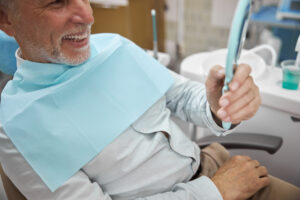 Take charge of your oral health by reading food labels, meal planning that limits sugars, and being highly committed to your oral hygiene routine at home. A few tips for a healthy mouth between dental check-ups are:
Take charge of your oral health by reading food labels, meal planning that limits sugars, and being highly committed to your oral hygiene routine at home. A few tips for a healthy mouth between dental check-ups are:
• Brush twice a day (at least) for two minutes each time. Use a fluoride toothpaste with a soft to medium bristle toothbrush.
• Floss your teeth every day before your brush to dislodge food particles caught between teeth. If flossing is difficult for you, try one of the water flossers. These are affordable and as effective as manual flossing.
• Brush your tongue after your teeth to unroot embedded bacteria, especially reaching the back area of the tongue (where most bacteria are embedded).
• Use an oral rinse that replenishes moisture twice a day (or as directed). These are available at most drug stores.
• Chew sugarless gum, preferably a brand that contains Xylitol. Xylitol looks and tastes like sugar, yet has 40 percent fewer calories.
• Drink plenty of water throughout the day. Be aware that beverages such as most coffee, tea and colas contain caffeine are drying to the mouth. Many medications also have the side effect of oral dryness – another good reason to stay hydrated.
Also, be aware of the signs and symptoms of gum disease. Sore, tender, bleeding, swollen or red gums are all warning signs. With prompt measures, we can greatly minimize treatment needs to rid your mouth of this dangerous bacteria that has been associated with a number of serious health problems (including stroke and some cancers).
If you haven’t seen your general dentist on a regular basis, call 828-274-9440. Our Asheville periodontal office can help to restore your mouth to a healthy state with the most conservative, yet effective, treatment possible.
Why You’re Losing Teeth (and how to halt the process)
Posted on Jul 29, 2021 by William J. Claiborne, DDS MS
The inevitable. Murphy’s law. Sooner or later.
It is to no surprise that life throws us occasional curves, some being out of the blue and others being somewhat predictable. As an Asheville Periodontal Specialist, one that comes to mind is the path to losing teeth.
Losing natural teeth is a challenge to both oral and overall health. And, there’s nothing that will definitively replace natural teeth once they’re extracted (although dental implants come pretty close!). Keeping natural teeth and gums healthy is the best way to support your health as you age.
According to a 2017 article published by Dentistry Today that shared recent study findings:
“people who had lost 5 or more teeth by the age of 65 years were more likely to suffer from cardiovascular disease, diabetes, and osteoporosis, all of which could severely limit life expectancy. Many of these illnesses previously have been linked to a person’s quality of life and socioeconomic status. The study concludes that the number of teeth in aging humans can affect longevity and life expectancy.”
https://www.dentistrytoday.com/news/industrynews/item/1632-life-expectancy-linked-to-number-of-teeth
Of course, no one wants to lose a natural tooth. Yet, many people assume that tooth loss is simply a natural part of the aging process. It’s not.
Through the years, certainly, accidents, injuries, decay, gum disease and deep fractures in teeth can result in loss of teeth. Regardless of how committed some people are to their oral hygiene regimen at home and regular dental check-ups, unexpected occurrences can lead to the need for an extraction.
However, the people who are committed to their oral health are far less likely to endure the undesirable outcome of tooth removal. The measures are simple and take very little time.
• Brush your teeth at least twice a day, for a minimum of two minutes each time.
• Floss daily.
• Avoid snacking and limit sugar.
• Drink plenty of water.
• See your dentist twice a year for exams and cleanings.
• Don’t smoke.
Although smoking cessation is a tough task for most people, the other items listed above require just minutes a day and cost very little. What they help you accomplish is PREVENTION. Rather than have problems treated, many instances surrounding tooth loss could have been prevented.
It is far less costly and time consuming to be attentive to your oral health than deal with the repercussions of insufficient oral upkeep. Losing a tooth will require a lifelong commitment, regardless of how it is replaced. And, replacing teeth is absolutely necessary.
When a tooth is lost, whether it can be seen in a smile or not, it no longer supports the surrounding teeth. The tooth above (or below) can elongate. Neighboring teeth can tilt or turn since they lack the bolstering affect provided by the now-missing tooth.
These factors can lead to chipped, fractured or broken teeth. They can also be an issue in bite misalignment. A misaligned bite can cause stress or strain on the temporomandibular joints (TMJ). The results can be frequent headaches, sore jaw joints, ear ringing, dizziness, and difficulty opening the mouth fully.
Another problem lies in the absence of the missing tooth’s roots. When these roots are missing, there is a lack of stimulation and nourishment to the jaw bone in this area. Without this, the bone begins to shrink, or resorb. Bone mass decline affects the stability of the adjacent teeth. It is known that the next tooth to be lost will most likely be one bordering a missing one.
The path to tooth loss, other than accident or injury, is actually a pretty predictable one. For people who take their oral hygiene lightly, it’s not a matter of “if” but “when”. Bacteria buildup in the mouth should be removed regularly, which is why twice-daily brushing is advised. If not thoroughly removed, their growth runs rampant.
Saliva flow helps in moving some bacteria out of the oral cavity. However, as people age, saliva flow decreases. Add to that the many elements that are drying to oral tissues: caffeine (including coffee, tea and colas), many medications, snoring, and some health conditions.
Oral bacteria that accumulate in the mouth for more than 48 hours first create a sticky film that coats the teeth and gums. This is plaque. If not removed through brushing and flossing, plaque transforms into hardened masses on the base of (or between) some teeth. This is tartar, which can no longer be brushed or flossed away.
As tartar spreads, the gums become inflamed. This causes gingivitis – the first stage of gum disease. Gingivitis causes the gums to become tender, swell, and sometimes bleed when brushing. Breath odor can become frequently bad.
If not resolved quickly, gingivitis can progress into full-blown gum disease. At this stage, the gums are red, inflamed, tender, bleed easily and breath odor is bad, even shortly after brushing.
As gum disease worsens, gums loosen their strong seal around the base of teeth. This allows entry of these infectious bacteria below the gum line. The structures that support natural teeth (including bone) are attacked, which can cause some teeth to loosen.
The advanced stage of gum disease is periodontitis. This means that gum tissues are red, spongy, have pockets of pus, bleed even when eating, and breath odor is putrid. To add insult to injury, this devastation doesn’t remain only in the mouth. Through tears in diseased gum tissues, the inflammatory bacteria of gum disease can enter the bloodstream.
This bacteria has been linked to serious, even life-threatening, health problems, as severe as stroke, heart disease, some cancers and Alzheimer’s disease. It can cause inflammatory triggers that worsen diabetes and prostatitis and cause preterm births.
Obviously, it’s important to keep your teeth and gums healthy. And, if tooth loss does occur, consider replacing it/them with dental implants. As an Asheville periodontist, one of my areas of advanced skill is in dental implant diagnosis and placement.
Dental implants are the closest thing to the look, feel and function of natural teeth. They restore dependable biting and chewing, without the need to be removed for cleaning. Best of all, confidence in smiling and laughing returns.
We frequently see Western NC adults who feared they would lose teeth due to periodontal disease and/or had already lost one or more natural teeth. Through our advanced skills and computerized technology, we are often able to fully restore people to excellent oral health and halt the progression of tooth loss.
If you have avoided seeing a dentist because of fear or anxiety, please know that we provide our patients with an environment of respect and comfort. We offer I.V. sedation (‘twilight sleep’) as well as oral sedation to create a totally relaxed state throughout treatment.
If cost is a concern, we also have payment plans that can help you achieve the smile you desire while making monthly payments that fit your budget.
Why allow tooth loss to happen? It CAN and SHOULD be prevented and we can help you regardless of your current oral condition. Call 828-274-9440 to request a consultation appointment. This will take place in a private consultation room where your questions will be answered thoroughly.
Why Seek A Periodontist For Dental Implants
Posted on Jul 13, 2021 by William J. Claiborne, DDS MS
Like many people, I value my relationship with my Internist. Through his care, I am confident that he understands my specific needs to oversee all aspects of my health.
Some of this care occasionally involves being referred to a specialist. For example, my Internist may advise me to see a dermatologist for a particular skin condition. Together, my internist and the dermatologist are able to work in unison so I’m receiving the proper treatment plan according to my particular needs.
I am also a specialist in the dental field. I am a periodontist, which is a specialist who receives most patients through referrals by a general dentist or another dental specialist. This is because a periodontist offers a unique set of skills as well as an advanced level of understanding when it comes to oral tissues and dental implants.
The American Academy of Periodontology defines a Periodontist as: “A periodontist is a dentist who specializes in the prevention, diagnosis, and treatment of periodontal disease, and in the placement of dental implants. Periodontists are also experts in the treatment of oral inflammation. Periodontists receive extensive training in these areas, including three additional years of education beyond dental school. They are familiar with the latest techniques for diagnosing and treating periodontal disease, and are also trained in performing cosmetic periodontal procedures.”
(https://www.perio.org/consumer/what-is-a-periodontist)
To reach this specialty requires an individual to be highly committed. A periodontist begins education by completing 4 years of college (undergraduate training) and then continues another 4 years in dental school to earn a doctorate. To specialize in Periodontics, he or she must further their education for another 3-4 years before completing the stringent requirements for a specialty certification in periodontics.
In addition to treating all phases of periodontal (gum) disease, a periodontal specialist is uniquely qualified to reshape gum tissues. This may be performed to correct a “gummy smile” or even out a smile line through crown lengthening. Periodontists also specialize in the diagnosis and placement of dental implants.
The advantages of a periodontist in dental implant treatment are multi-faceted. This specialist is trained to understand the intricate concepts involved in selecting the proper type of implant and skilled at placing implants at proper depths and angles. A periodontist is also able to optimize patient comfort during treatment and throughout the healing phase.
Using his or her advanced training in the diagnosis and placement of dental implants, a periodontist can help you enjoy a higher potential for dental implant treatment that lasts a lifetime. There are a number of reasons you should strongly consider having a periodontal specialist involved in dental implant treatment, including:
SELECTION OF IMPLANTS – Dental implants come in a wide array of shapes and sizes. Each system is designed to accommodate certain needs and preferences. For example, some implants are designed to support a full arch of teeth while others can be placed in areas where a great deal of bone loss has occurred. The selection of the implant type that is appropriate for your needs and goals requires a unique understanding of all implant types. That is, a periodontist can select the type that will work best for you rather than go with the one or two in which they have received training.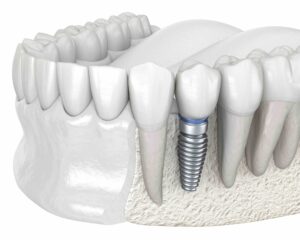
PLACEMENT OF IMPLANTS – In addition to selecting the best type for your needs, proper placement of implants has a great deal to do with having a successful outcome. When an implant that is too long, for instance, is placed in bone that is too shallow, it can have future repercussions that may require its removal. This could occur when a lower implant is placed too close to a nerve that runs horizontal through the jaw bone (mandible). Or, when an upper implant is placed in shallow bone, it can work its way into the sinus cavity. A periodontal specialist considers intricate factors that can effect your potential for success.
STRUCTURAL ISSUES – In addition to the factors involved with bone loss, other issues can ‘make or break’ having a successful treatment outcome with dental implants. For example, for people who have bite misalignment or TMJ disorders, they may be grinding or clenching their teeth during sleep – often unknowingly. Telltale signs of ‘bruxing’ including remaining, natural teeth that are chipped or worn. These forces are enough to crack a walnut. When dental implants endure these forces, especially during their ‘healing’ phase, there is greater risk for implant failure. A periodontist considers these issues prior to your treatment, helping you to bypass problems that can result in eventual removal.
INDIVIDUALIZED TREATMENT CONSIDERATIONS – Our goal is to help you get the most from your dental implants. When there are individual habits or preferences that can complicate success, we work with each patient to help them enjoy their dental implants for a lifetime. For smokers, we advise ways to support saliva flow and minimize oral bacteria levels. For people who take certain medications that can interfere with oral moisture, we recommend methods to keep the mouth properly hydrated. And so on. We want to make sure your care is individualized so your potential for implant success is high!
OPTIMAL COMFORT – For added comfort and relaxation, we offer Oral sedation or I.V. sedation (twilight sleep) for most procedures for those who want or need these options. Both sedations are administered to the highest standards of safety possible. Our sedated patients are closely monitored throughout treatment with advanced safety equipment and trained professionals. Oral sedation is a pill that helps patients relax. It also has an amnesiac effect, leaving most with little or no memory of treatment afterward. I.V. sedation places the patient in a deeper sedative state, also erasing memory of the procedure. At our Asheville office, Biltmore Periodontics administers sedation with the involvement of a highly-trained doctor of anesthesiology for optimal comfort and safety.
For individuals who wish to replace one or more missing teeth, it makes sense that dental implants have become the leading preference. Dental implants restore the look, feel, and function like that of natural teeth. They also help to prevent bone shrinkage that occurs when tooth roots are no longer present in the jaw bone. This process is known as resorption.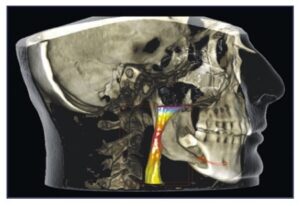
Resorption is what contributes to changes in facial appearance when the bone structures that give the face its shape start to shrink. When tooth roots no longer exist in the jaw bone, the stimulation once provided to the bone no longer exists. This causes the bone to shrink, or ‘resorb.’
As the bone mass declines in height and thins out, changes in facial appearance slowly evolve. For example, as the jaw bone thins, deep wrinkles form around the mouth. Eventually, the corners of the mouth will turn down even in a smile. Jowls form on each side of the face as facial muscles detach from the shrinking bone structure.
As the jaw bone continues to shrink, the chin becomes more pointed and the nose seems to get closer to it. This leads to a collapsed mouth that is known as a ‘granny look.’ This look ages the appearance of an individual far beyond their actual years.
Among the many benefits of dental implants, they also provide stimulation to the jaw bone. This helps to halt the process of bone loss. For those who have already lost a great deal of bone, bone rebuilding procedures can be performed to restore a healthy, more youthful face shape.
In addition to all the advantages of care through a periodontist, our Asheville periodontal office features some of the most advanced technology available. This includes laser dentistry and cone beam imaging as well as highly-advanced computerized options.
If you’ve considered dental implants to replace missing teeth, we invite you to consult with us during a private consultation appointment. A referral is not necessary. During this time, we will discuss your needs and goals as well as any concerns regarding comfort or costs.
To schedule, call (828) 274-9440.
Recent Posts
Categories
Archives
- September 2024
- August 2024
- July 2024
- June 2024
- May 2024
- April 2024
- March 2024
- February 2024
- January 2024
- December 2023
- November 2023
- October 2023
- September 2023
- August 2023
- July 2023
- June 2023
- May 2023
- April 2023
- March 2023
- February 2023
- January 2023
- December 2022
- November 2022
- October 2022
- September 2022
- August 2022
- July 2022
- June 2022
- May 2022
- April 2022
- March 2022
- February 2022
- January 2022
- December 2021
- November 2021
- October 2021
- September 2021
- August 2021
- July 2021
- June 2021
- May 2021
- April 2021
- March 2021
- February 2021
- January 2021
- December 2020
- November 2020
- October 2020
- September 2020
- August 2020
- July 2020
- June 2020
- May 2020
- April 2020
- March 2020
- February 2020
- January 2020
- December 2019
- November 2019
- October 2019
- September 2019
- August 2019
- July 2019
- June 2019
- May 2019
- April 2019
- March 2019
- February 2019
- January 2019
- December 2018
- November 2018
- October 2018
- September 2018
- August 2018
- July 2018
- June 2018
- May 2018
- April 2018
- March 2018
- February 2018
- January 2018
- December 2017
- November 2017
- October 2017
- September 2017
- August 2017
- July 2017
- June 2017
- May 2017
- April 2017
- March 2017
- February 2017
- January 2017
- December 2016
- November 2016
- October 2016
- September 2016
- August 2016
- July 2016
- June 2016
- May 2016
- April 2016
- March 2016
- February 2016
- January 2016
- December 2015
- November 2015
- October 2015
- September 2015
- August 2015
- July 2015
- June 2015
- May 2015
- April 2015
- March 2015
- February 2015
- January 2015
- December 2014
- November 2014
- October 2014
- September 2014
- August 2014
- July 2014
- June 2014
- May 2014
- April 2014
- March 2014
- February 2014
- January 2014
- December 2013
- November 2013
- October 2013
- September 2013
- August 2013
- July 2013
- June 2013
- May 2013
- April 2013
- March 2013
- February 2013
- January 2013
- December 2012
- November 2012
- October 2012
- September 2012
- August 2012
- July 2012
- June 2012


